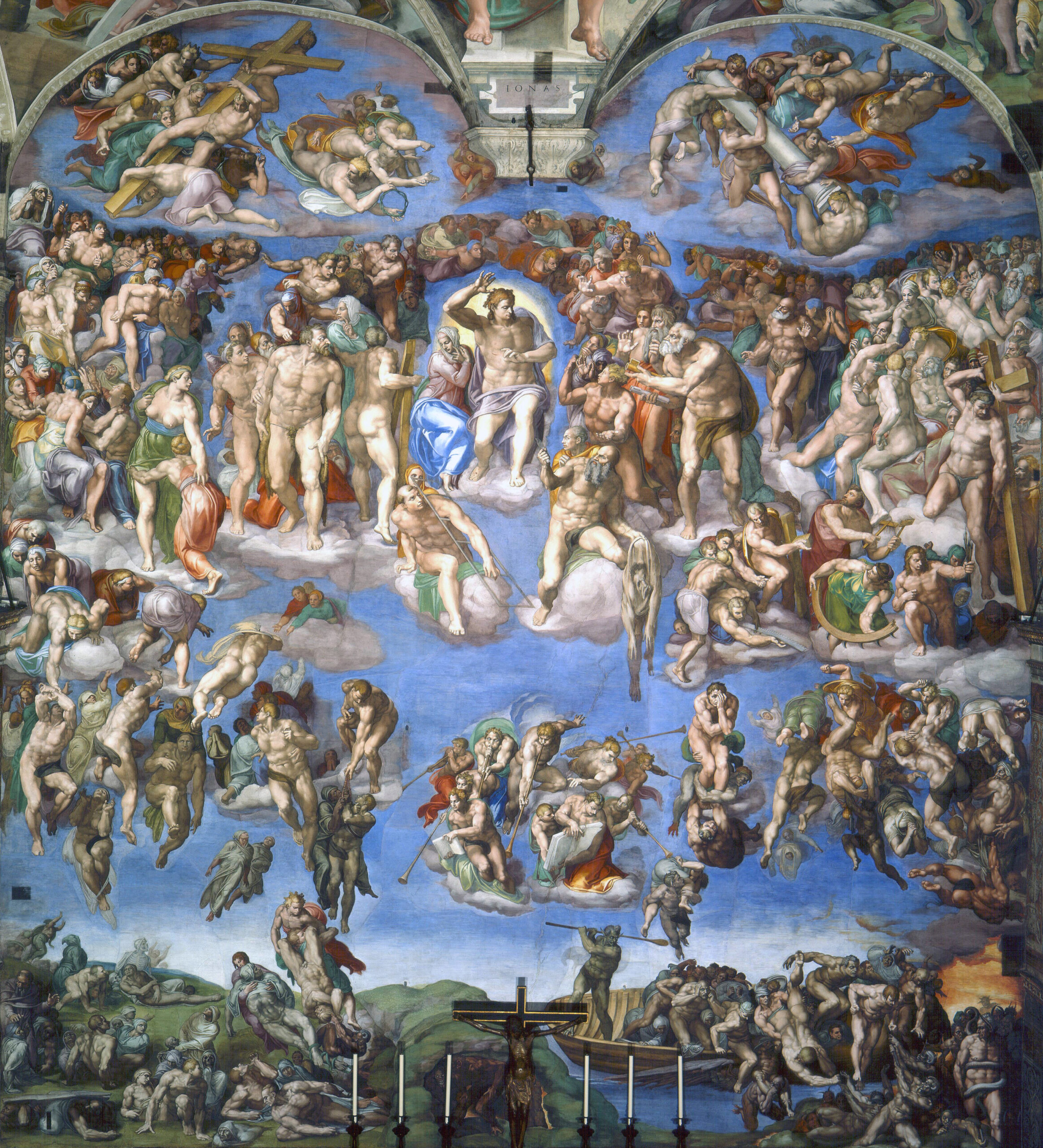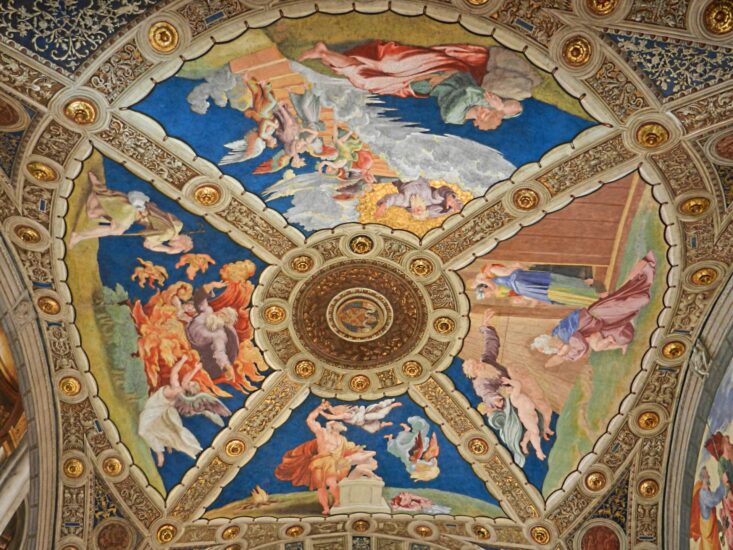フレスコ画って皆さん聞いたことありますか?
西洋美術史を学ぶ上で、必ず知っておきたいアート技法の一つ。
今回は、フレスコ画とは一体何なのか、歴史や描き方、有名絵画までをわかりやすく解説していきますが、テンペラ画の記事「テンペラ画について – 技法や歴史を日本語と英語で解説します」と同様に、日本語と英語、2言語で説明します。
なぜ私が英語と日本語で解説するようになったかというと、西洋美術史を英語で理解できるようになると、海外で作品を観るときに数十倍楽しくなるから。私がロンドンに来たばかりのときは、美術館に並ぶ絵画の横の解説が理解できずにとても悔しい思いをしていました。なので、みなさんが海外旅行に訪れたときに、もっと西洋美術を身近に感じてもらえたらと思って、このやり方を始めることにしました。一緒に勉強していきましょう!
(覚えておいたほうが良い美術でよく使われる単語には下線を引いています)
解説をはじめる前に、絵画の歴史がとてもわかり易くまとめてある私のおすすめの本をご紹介させてください。解説の中でも度々使用させていただいています。内容は全て英語ですが、比較的簡単な英語で気になる方はぜひ購入してみてください。日本では残念ながら売っておらず、リンクはイギリスのアマゾンですが、登録すれば取り寄せ可能のはずです。(リンクはイギリスアマゾンのアフィリエイトリンクです)

The Story of Painting: How art was made
1. フレスコ画とは? – What is fresco?
フレスコ画とは、濡れた漆喰の上に水性絵の具を直接塗り、絵の具が漆喰と一体化した状態にする壁画技法のこと。
Fresco is a mural painting technique that involves painting with water-based paint directly onto wet plaster so that the paint becomes an integral part of the plaster.
TATE
2. フレスコ画の描き方 – Fresco Technique
イタリア語で「新鮮」を意味するフレスコ画は、純粋な粉末状の顔料と水のみと混ぜ合わせたものを、湿っている”新鮮”な漆喰を施した壁や天井に直接塗っていく技法。画家たちは一回に小範囲を描いていき、漆喰が乾く前に絵と壁を一体化させていった。
乾いた漆喰に絵の具を塗る「フレスコ・セッコ※」という技法で描かれたフレスコ画もあるが、初期イタリア画家が最高の技法だとして使っていたのは「ブオン・フレスコ(上記で述べた技法)」であった。
※…「フレスコ・セッコ」は乾いた漆喰の上に描かれるため、顔料を壁に付着させるための結合剤(例:卵テンペラ、糊、油)を必要とする技法。有名な絵画はレオナルド・ダ・ヴィンチの最後の晩餐。下で詳しく説明。
Meaning “fresh” in Italian, fresco involved applying pure powdered pigments, mixed only with water, straight onto a wet, freshy laid layer of lime plaster on a wall or ceiling. Artists had to work quickly in small sections at a time, before the plaster dried, so the painting became an integral part of the wall.
Some paintings were also made using fresco secco, in which paint was applied to plaster that had already dried, but it was buon fresco (true fresco) that early Italian painters considered best.
The Story of Painting
下記の動画は英語でフレスコ画の歴史から技法まで詳しく説明していますので、もっと細かく知りたい方はおすすめです。
3. フレスコ画の歴史 – History of Frescoes
フレスコ画は、紀元前2000年頃、クレタ島(ギリシャ)の青銅器文明の時代にミノア人によってすでに行われていたと言われており、有名なクレタ島のブオン・フレスコ壁画には「トレアドール」がある。初期のフレスコ画は、モロッコやエジプトでも描かれており、エジプトの芸術家は墓の壁画にフレスコ・セッコ方式を好んで用いていた。
フレスコ画は、ギリシャ美術、エトルリア(イタリア半島の中部)美術、ローマ美術でもよく見られ、それらでは主にブオン・フレスコ方式が採用されていた。ローマの初期キリスト教美術、特にカタコンベ(地下墓所)では、フレスコ壁画が描かれている。このフレスコ画は、古代地中海やトルコの芸術家たちに人気があった。また、インドのアジャンタ石窟やブリハディスヴァラ寺院においては、紀元前200年から1100年の間に完成した初期の仏教フレスコ画が発見されている。
Fresco was practised as early as 2000 BCE by the Minoans during the bronze age civilization of Crete. Famous Cretan buon fresco wall paintings include “The Toreador”. Early frescoes were also painted in Morocco and Egypt, with Egyptian artist preferring the secco method for their tomb murals.
Fresco paintings were also common in Greek art, as well as Etruscan culture and in Roman art, where they were mainly executed in buon fresco style. Early Christian art in Rome, notably in the catacombs, also featured fresco murals.
Indeed the style was popular with artists throughout the ancient Mediterranean and in Turkey. In addition, early examples of Buddhist fresco art, completed between 200 BCE and 1100 CE, were discovered at the Ajanta caves and the Brihadisvara Temple in India.
ENCYCLOPEDIA OF FINE ART
4. 知っておきたい、フレスコ画の有名作品 – Fresco famous paintings that you should know
・ミケランジェロ Michelangelo / システィーナ礼拝堂天井画 Sistine Chapel Ceiling

ミケランジェロは、1508年に教皇ユリウス2世から礼拝堂のヴォールト(天井)の塗り替えを依頼され、1508年から1512年末にかけて完成させた。 また、1535年から1541年に、教皇パウルス3世(ファルネーゼ)からの依頼で、祭壇の上に「最後の審判」を描いた。<省略> 描かれた面積は、縦40m×横13mほど。つまり、ミケランジェロは460m2を超えるフレスコ画を描いたことになる。
Michelangelo was commissioned by Pope Julius II in 1508 to repaint the vault, or ceiling, of the chapel. The work was completed between 1508 and late 1512. He painted the Last Judgment over the altar, between 1535 and 1541, on commission from Pope Paul III Farnese. <省略> The painted area is about 40 m long by 13 m wide. This means that Michelangelo painted well over 460 m2 of frescoes.
Wikipedia


・レオナルド・ダ・ヴィンチ LEONARDO DA VINCI / 最後の晩餐 ‘The Last Supper’

最後の晩餐 ‘The Last Supper’ / サンタ・マリア・デッレ・グラツィエ修道院(ミラノ) Convent of Santa Maria delle Grazie
「最後の晩餐」は、レオナルド・ダ・ヴィンチの傑作であり、現存する彼の唯一のフレスコ画。ミラノのサンタ・マリア・デッレ・グラツィエ修道院の食堂の壁に描かれたこの作品では、伝統的なフレスコ画の手法を逸脱して描かれた。ダ・ヴィンチはフレスコ画の色と色調の強さを高めることを目指し、「フレスコ・セッコ」という実験的な技法を採用した。これは、乾いた漆喰の上に油性の釉薬をかけたテンペラを塗り、乾燥時間を長くすることで、特徴的な色調のブレンドやドローイングの微調整を可能にしたのである。
The Last Supper by Leonardo da Vinci is his largest painting and only fresco to survive. <省略>In this painting on the refectory wall (dining room) of the monastery of the Santa Maria delle Grazie in Milan, he deviated from the traditional method of fresco painting. His aim was to try to increase the strength of fresco color and tone, and he employed an experimental ‘fresco secco’ technique, applying tempera with oil glazes on dry plaster. This increased the drying time of the medium which allowed him to create his characteristic blends of tone and make adjustments to his drawing.
Arty Factory
・ラファエロ Raphael / ラファエロの間 Raphael Rooms

ラファエロの間は、バチカン宮殿内に4つの部屋で構成されており、教皇ユリウス2世(1503年から1513年までの教皇)の居室の一部であった。各部屋の壁には、宗教や神話などのさまざまな物語を描いた巨大なフレスコ画が描かれており、その美しさには目を見張るものがある。巨匠ラファエロの名を冠したこれらの部屋は、ラファエロ自身が設計したもの。作品の多くはラファエロ自身が描いたものであるが、部屋が完成する前に1520年に急逝したため、ラファエロの生徒たちが残りを完成させた。
Raphael’s Rooms comprise four separate rooms in the Palace of the Vatican and they formed a part of the apartment of Pope Julius II (pontiff from 1503-1513). The walls of each room are beautiful with their immense frescoes that depict a variety of religious and mythological stories. Named after the master Raphael, these rooms were designed by Raphael himself. While a large number of the artworks were painted by Raphael, many of them needed to be completed by the students of the School of Raphael, due to the artist’s unexpected death in 1520 before the completion of the rooms.
Sightseeing tours Italy
いかがでしたでしょうか?フレスコ画が天井や壁一面に繊細に描かれているのがとても印象的でしたね。
それでは、別の美術史解説の記事まで。

